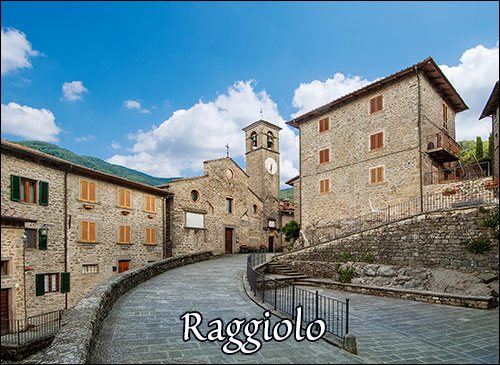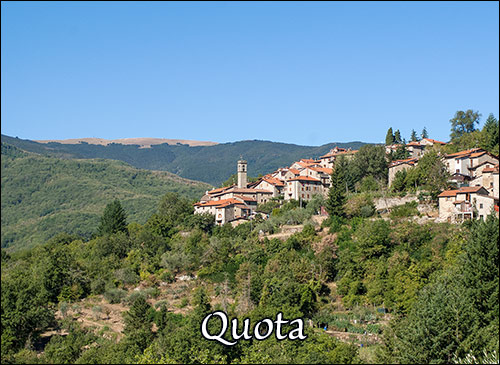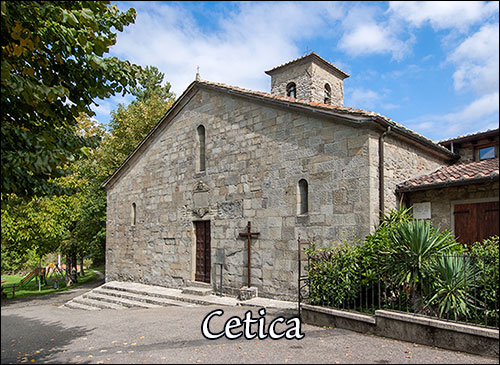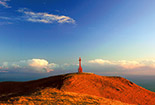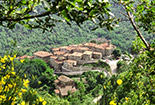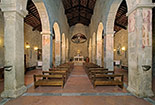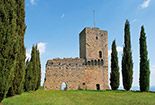Montemignaio, an ancient castle
on the Casentino slopes of the Pratomagno massif
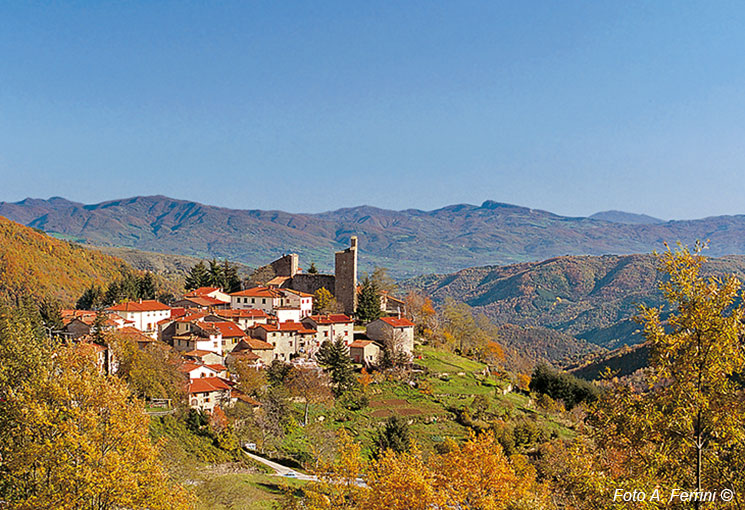
Texts and photos by Alessandro Ferrini ©
33 images in sequence for a virtual journey in the mountain territory of Montemignaio. Click to enlarge.
A castle and a Romanesque church on the slopes of Pratomagno: Montemignaio
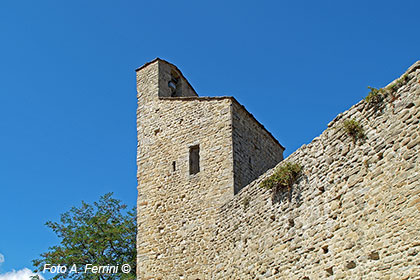 Montemignaio can be reached by climbing from Strada in Casentino or from a detour on the Strada della Consuma two kilometers from the pass of the same name.
Third alternative is to go down from Monte Secchieta. In this case we will have a top view of the place before arriving there and a tower will catch our attention. This element anticipates that this village was born on the remains of a castle – a very common thing for the villages on slopes of Pratomagno. The whole area had been under the dominion of the Guidis since the 11th century. It used to be a very important territory, for it was a kind of outpost toward Florence. In the 11th century, this was a valid reason to build a fortification that took the name of Castel Leone. Entering this village, you will notice that besides the tower, there still are parts of the castle’s walls. There also is a beautiful door, but it was opened only in the 19th century. The small hamlet beyond the door is very pleasant to visit. The oratory of Sant’Agata is also very interesting, it has its origins in a chapel built during the first half of the 14th century and its gate is of evident Gothic style. On the above lunette, there is the crest of the “Arte della Lana”, a very important Florentine company that surely had close commercial relationships with this place of shepherds when, at the end of the 14th century, the Counts Guidi took dominion of the castle. The history of this territory began way before the Counts Guidi, though. A Roman road used to pass from here and perhaps, the name Montemignaio derives from the presence in this area of a milestone, the Mons Miliarius. Also the Longbards got to know this place during their advance in Casentino from Passo della Consuma.
The name Montemignaio refers not only to a village, but also to a territory formed of several inhabited centers. The two most important amongst them are Castello – of which we already talked about – and Pieve, so called for the presence of a Romanesque church that we are going to analyze later. It is difficult to assign an altitude to Montemignaio. The official one is 740 meters, which refers to the Town Hall, but the castle is already over 800 meters. From here, an enjoyable road surrounded by greenery leads to Passo della Consuma. After a couple of kilometers, a crossroads on the right leads down to the nearby Oratorio della Calle.
Montemignaio can be reached by climbing from Strada in Casentino or from a detour on the Strada della Consuma two kilometers from the pass of the same name.
Third alternative is to go down from Monte Secchieta. In this case we will have a top view of the place before arriving there and a tower will catch our attention. This element anticipates that this village was born on the remains of a castle – a very common thing for the villages on slopes of Pratomagno. The whole area had been under the dominion of the Guidis since the 11th century. It used to be a very important territory, for it was a kind of outpost toward Florence. In the 11th century, this was a valid reason to build a fortification that took the name of Castel Leone. Entering this village, you will notice that besides the tower, there still are parts of the castle’s walls. There also is a beautiful door, but it was opened only in the 19th century. The small hamlet beyond the door is very pleasant to visit. The oratory of Sant’Agata is also very interesting, it has its origins in a chapel built during the first half of the 14th century and its gate is of evident Gothic style. On the above lunette, there is the crest of the “Arte della Lana”, a very important Florentine company that surely had close commercial relationships with this place of shepherds when, at the end of the 14th century, the Counts Guidi took dominion of the castle. The history of this territory began way before the Counts Guidi, though. A Roman road used to pass from here and perhaps, the name Montemignaio derives from the presence in this area of a milestone, the Mons Miliarius. Also the Longbards got to know this place during their advance in Casentino from Passo della Consuma.
The name Montemignaio refers not only to a village, but also to a territory formed of several inhabited centers. The two most important amongst them are Castello – of which we already talked about – and Pieve, so called for the presence of a Romanesque church that we are going to analyze later. It is difficult to assign an altitude to Montemignaio. The official one is 740 meters, which refers to the Town Hall, but the castle is already over 800 meters. From here, an enjoyable road surrounded by greenery leads to Passo della Consuma. After a couple of kilometers, a crossroads on the right leads down to the nearby Oratorio della Calle. 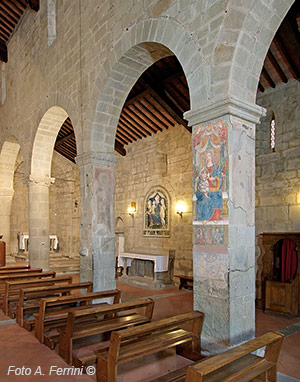 Its toponym says a lot about this place located on the thoroughfare between Montemignaio and Consuma. People used to count here for it used to be a sort of customs. What did people count, though? Generally, sheep in the period of transhumance. We know very little about the gracious oratory located along the Fosso Tiglieto. It should be replacing a tabernacle that used to be in this crossing point from the beginning of the 15th century.
There is another place, not far from Pieve, which is very interesting from an historical, architectural and environmental point of view. It is a hump- backed bridge of medieval origins. In order to visit it, it is necessary to go down the road that leads to Strada in Casentino for about one kilometer. A short path on the left leads to the bridge. These kind of medieval infrastructures, generally dating back to the 13th and 14th century, are very frequent in the Casentino territory, particularly those areas that descend from the slopes of Pratomagno. Other than showing their architectural charm, they always have something important to tell because their construction – not always easy – had to be economically justified. Usually, a bridge corresponded to a mill, an activity of primary importance in that period and in the following centuries.
After this short historic-naturalistic excursion, let us go back to the village to visit what can be considered the most important place in the area, the Church of Santa Maria Assunta. The church, of evident Romanesque style, can be dated to the 6th or 7th decade of the 12th century. On the inside, it presents the classical three naves. These naves, unlike its sisters of the upper Casentino (Strada, Romena and Stia) where they are separated by columns, are here divided by three couples of pillars at the entrance of the church and by four columns in the presbytery. They have interesting capitals with various motifs carved at their tops. The pillars, on the contrary, have simple capitals realized on thick stone slabs. In exchange, on parts of remaining plaster, portions of frescoes dating from the end of the 14th century are still visible. They are not the only form of art stored in the church: there are artworks of many kinds here. It is important to cite a 16th century board placed on the left wall representing the Virgin with the Child and the Saints attributed to Michele di Ridolfo del Ghirlandaio. On the opposite part of the building, there is a glazed terracotta dated around 1500 and attributed to Benedetto Buglioni, representing a Madonna with the Child between The Saints Antonio Abate e Sebastiano. Next to this, there is a small cuspidate panel on a gold background of a Virgin with the Child. It comes from the Oratorio della Calle and it was attribut- ed to the Florentine Rossello di Jacopo Franchi. Datable to the first half of the 15th century, it is called Madonna delle Grazie because it was considered miraculous by the local people. The pillars, the columns, the capitals and the above arches are the only architectural parts of this church dated back to the 12th century. Unfortunately, the Church of Montemignaio was built on an instable land that, during the centuries, caused several structural collapses. Many reconstructions involved the whole external part of the building. In the big reconstruction work of 1904, the facade was also moved backwards and the apse was enlarged, so much so that it became disproportioned compared to the wall. This church has known particular historic moments.
Its toponym says a lot about this place located on the thoroughfare between Montemignaio and Consuma. People used to count here for it used to be a sort of customs. What did people count, though? Generally, sheep in the period of transhumance. We know very little about the gracious oratory located along the Fosso Tiglieto. It should be replacing a tabernacle that used to be in this crossing point from the beginning of the 15th century.
There is another place, not far from Pieve, which is very interesting from an historical, architectural and environmental point of view. It is a hump- backed bridge of medieval origins. In order to visit it, it is necessary to go down the road that leads to Strada in Casentino for about one kilometer. A short path on the left leads to the bridge. These kind of medieval infrastructures, generally dating back to the 13th and 14th century, are very frequent in the Casentino territory, particularly those areas that descend from the slopes of Pratomagno. Other than showing their architectural charm, they always have something important to tell because their construction – not always easy – had to be economically justified. Usually, a bridge corresponded to a mill, an activity of primary importance in that period and in the following centuries.
After this short historic-naturalistic excursion, let us go back to the village to visit what can be considered the most important place in the area, the Church of Santa Maria Assunta. The church, of evident Romanesque style, can be dated to the 6th or 7th decade of the 12th century. On the inside, it presents the classical three naves. These naves, unlike its sisters of the upper Casentino (Strada, Romena and Stia) where they are separated by columns, are here divided by three couples of pillars at the entrance of the church and by four columns in the presbytery. They have interesting capitals with various motifs carved at their tops. The pillars, on the contrary, have simple capitals realized on thick stone slabs. In exchange, on parts of remaining plaster, portions of frescoes dating from the end of the 14th century are still visible. They are not the only form of art stored in the church: there are artworks of many kinds here. It is important to cite a 16th century board placed on the left wall representing the Virgin with the Child and the Saints attributed to Michele di Ridolfo del Ghirlandaio. On the opposite part of the building, there is a glazed terracotta dated around 1500 and attributed to Benedetto Buglioni, representing a Madonna with the Child between The Saints Antonio Abate e Sebastiano. Next to this, there is a small cuspidate panel on a gold background of a Virgin with the Child. It comes from the Oratorio della Calle and it was attribut- ed to the Florentine Rossello di Jacopo Franchi. Datable to the first half of the 15th century, it is called Madonna delle Grazie because it was considered miraculous by the local people. The pillars, the columns, the capitals and the above arches are the only architectural parts of this church dated back to the 12th century. Unfortunately, the Church of Montemignaio was built on an instable land that, during the centuries, caused several structural collapses. Many reconstructions involved the whole external part of the building. In the big reconstruction work of 1904, the facade was also moved backwards and the apse was enlarged, so much so that it became disproportioned compared to the wall. This church has known particular historic moments. 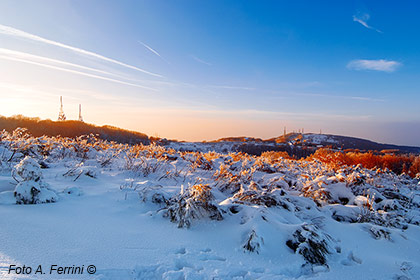 At the beginning of this text we mentioned Monte Secchieta. The mountain is located in the municipal area of Montemignaio and represents the final part, towards the north, of the Pratomagno massif. The top of the mountain, 1448 meters, is nine kilometers from the town. Always with the same distance we can reach it from the Vallombrosa Abbey. Monte Secchieta is clearly identifiable, even from very far away, due to the presence of three large wind turbines. The place is known for its majestic beech woods and the wide 360-degree panorama it offers. From up here you can admire a large part of the Casentino and Valdarno. On clear days we have a beautiful view of Florence and far beyond: up to the Pistoia Apennines and the Apuan Alps. Monte Secchieta offers nature trails suitable for trekking as well as for relaxing walks that require limited physical effort.
The sequential pages of this web section will begin by illustrating the aspects of this mountain, then we will descend to the town.
At the beginning of this text we mentioned Monte Secchieta. The mountain is located in the municipal area of Montemignaio and represents the final part, towards the north, of the Pratomagno massif. The top of the mountain, 1448 meters, is nine kilometers from the town. Always with the same distance we can reach it from the Vallombrosa Abbey. Monte Secchieta is clearly identifiable, even from very far away, due to the presence of three large wind turbines. The place is known for its majestic beech woods and the wide 360-degree panorama it offers. From up here you can admire a large part of the Casentino and Valdarno. On clear days we have a beautiful view of Florence and far beyond: up to the Pistoia Apennines and the Apuan Alps. Monte Secchieta offers nature trails suitable for trekking as well as for relaxing walks that require limited physical effort.
The sequential pages of this web section will begin by illustrating the aspects of this mountain, then we will descend to the town.
